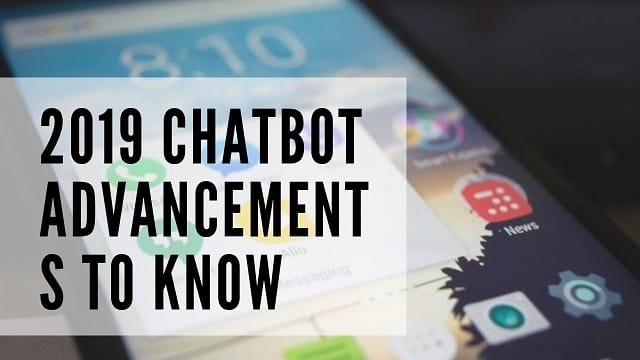In 1964, Joseph Weizenbaum began creating a computer program that attempted to process language and respond with human-like answers. Weizenbaum succeeded three years later with “Eliza,” a computer program that could have a fluid conversation with a human.
Eliza didn’t exactly pass the Turing Test, but neither can the vast majority of today’s chatbots. Technology does move fast, though — accelerating just a little bit more each year. So what does 2019 have in store for chatbots and voice assistants?
Here are three advancements to know:
Chatbots Passing the Turing Test with Flying Colors?
Even though most of the chatbots developed to-date don’t pass the Turing Test, that hasn’t exactly been developers’ goals. Instead, chatbot development has been geared toward helping customers with common, low-level inquiries or to carry out monotonous tasks within a company.
But with the rapid advancement of artificial intelligence (AI) and machine learning (ML), chatbots might soon be passing the Turing Test by sheer side effect. It’s unlikely we’ll see chatbots ascend over this bar completely in 2019, but the line is becoming less clear. As Jelani Harper writes for AI Business, deep learning is responsible, making chatbots appear more sophisticated than their simplistic, template-based approaches we’ve conventionally seen.
Noticeable areas of improvement will be in the nuanced details that make human language intricate and beautiful; specific dialects, pauses in language and other authenticities chatbots haven’t tapped into yet will give us the feeling that we’re conversing with a human responding to our exact words. Not only will the chatbots and smart assistants of the future be able to do more complex things (like figure out how to build an e-commerce website on Shopify with a good user interface), but they’ll also be able to explain them in straightforward, human-sounding terms as an acquaintance, friend or teacher would.
Multi-Use Chatbots in Large Enterprises
Large companies are typically thought of as slow-moving when it comes to adopting current tech trends. But that’s far from the case with chatbots. According to a Spiceworks study, 40 percent of large businesses (500 or more employees) are expected to implement chatbots or intelligent assistants in 2019 compared to 25 percent of mid-size companies and 27 percent of small businesses. While the study mentions that some businesses are hesitant to introduce chatbot for either a lack of use cases or privacy concerns, around 24 percent of large orgs currently use them to handle work-related tasks.
The most commonly used intelligent assistant in the workplace? Microsoft Cortana, used by just under half (49 percent) of companies surveyed, narrowly edging out Apple Siri, leveraged by 47 percent of businesses. Companies are primarily using intelligent chatbot assistants for voice-to-text dictation (46 percent), with support team collaboration tasks (26 percent) and employee calendar management (24 percent) also common. Yet, just 14 percent of businesses are using chatbots for customer service, and 13 percent for help with IT help desk management, respectively.
But usage is higher within IT departments on the whole, with 53 percent of orgs using them in their IT departments, 23 percent for administrative support, and 16 percent in sales-and-marketing endeavors.
In 2019, as adoption rises in large companies, departments across organizations will start to use and have more confidence in chatbot assistants (which will really function more like AI-assistants) to help fuel their workloads.
Better Voice Search Capabilities and More Voice Programs

Mobile’s been all the rage for a while, solidified by Google’s official shift to mobile-first indexing in spring 2018. But long-term, it’s clear that everything is headed to voice search. As Christi Olson writes for Campaign, we saw it with 2013’s “Her” — a refreshing, atypical rom-com detailing Joaquin Phoenix and an AI assistant falling in love with one another. Though that’s not possible now, that level of authenticity is surely on the horizon. Per Chatbotslife, an estimated 80 percent of communications will be carried out with the help of robots within the next five years. And they won’t all be programs we’ve come to know, either. Look for more voice-based programs to surface for particular uses and keep us in the know about what’s important to us.
Read Also :Social Media Marketing: Can Social Media Grow Your Business
For home assistants specifically, the foundation is set in 2019 for adoption to take a noticeable leap forward. It’s estimated that approximately half of all U.S. households already own a voice assistant. This technology is poised to get much better through speech recognition and natural language programming that will be better at problem-solving and making their users’ daily tasks — such as waiting on hold, paying bills and shopping — more convenient. In fact, the voice-shopping market is expected to grow from $2 billion from the start of 2018 to $40 billion by 2022. This can, and will only happen with more fluid and frustration-free human-to-voice-assistant interactions.
These are just three general advancements chatbots will make in 2019 and beyond. Zooming in highlights plenty of granularities such as serverless technology that allows automated call centers to run without downtime, AI chatbot apps, and overall more personalized assistance for the user, whether that’s a consumer asking for information in their kitchen or a company trying to automate their data collection and analyzation. One thing’s for sure, though; our lives will only get easier from a task-execution standpoint, at least, if we want it to.

